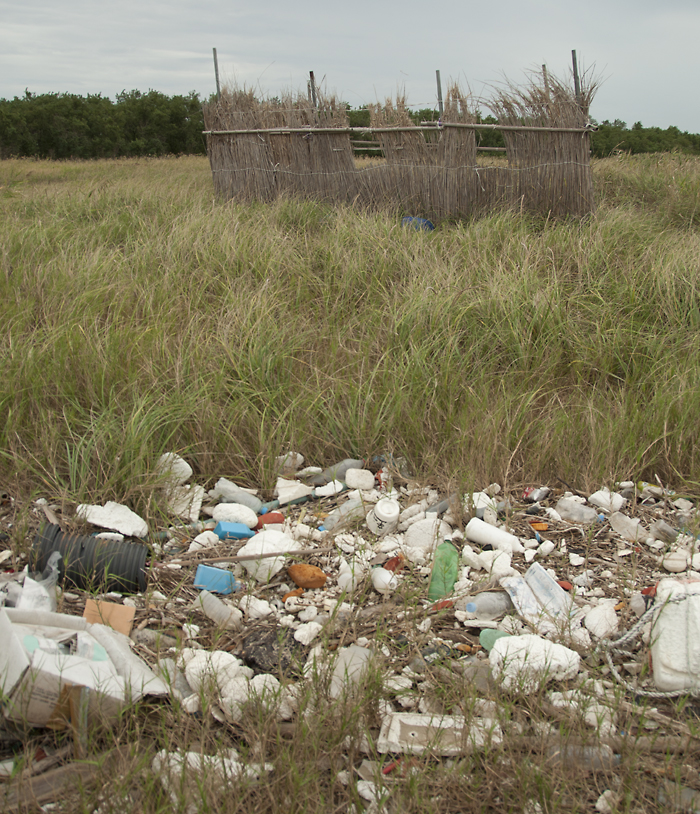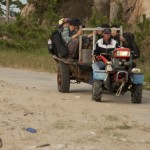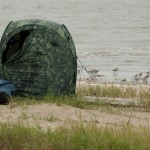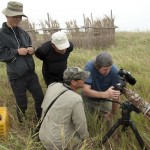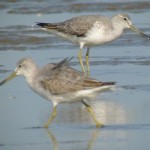Read all posts from this expedition to South Korea
Are you a birdwatcher who doesn’t like to get up early?
This is roughly the equivalent of a baker who’s allergic to butter. But, like margarine for the lactose intolerant, there are options out there for birders who’d rather study the back of their eyelids over the dawn chorus.
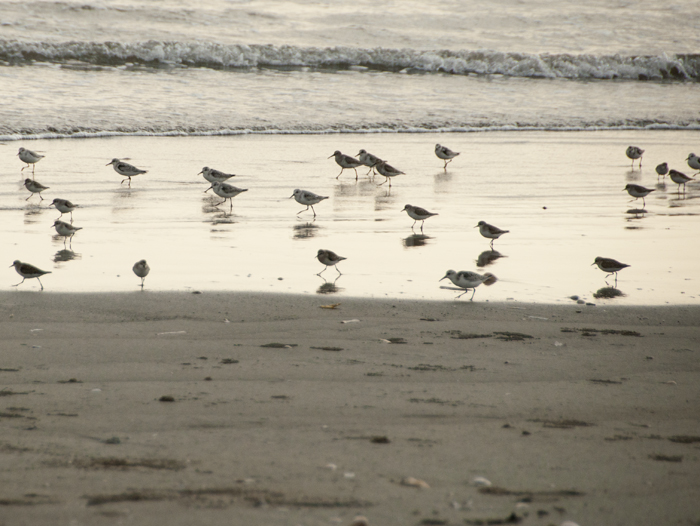
Shorebirds.
All you need to do is check the tide charts, then show up an hour or two before high tide and wait for the rising water to—gradually—bring the birds closer to you. And, thankfully, this important rule of shorebirding provided us with a much-needed morning off, the first and last on the ten-day trip.
After a relaxing morning of checking gear and email, we grabbed our bags and drove back to the boat dock, arriving by noon. Unfortunately, bad news awaited us: the boat was already filled with bird photographers, and even more were waiting on Yubu Island.
As we were bringing our equipment down to the boat, Jason Laughry from Birds Korea politely asked the group of mostly Korean men if they could keep their voices down when the high tide pushed the birds towards the reeds, where they usually set up their chairs and blinds. With a couple shrugs and some abrupt Korean, his request was quickly dismissed. Unfortunately neither the stature of the Cornell Lab of Ornithology, nor the geographic breadth of this project, could persuade them to reduce disturbance. Nor did the towering 6’7” frame of Gerrit Vyn, Cornell’s multimedia producer and head of the expedition.
It was an awkward ten-minute boat ride to Yubu Island as our two groups faced one another in silence. Upon landing, we quickly loaded our gear onto the tractor with the other photographers, and Jason and I grabbed our scopes and headed out on foot, hoping to beat the chugging beast to the beach.

The weather was warm and humid again, but the trek was much easier than the previous afternoon, when I had optics, bags, or optics-related bags draped from every appendage.
Jason and I set up our tripods as soon as we got to the beach, staking our claim on a small stretch of the high tide mark that faced east, ideal positioning for the afternoon sun. Jason pointed out a string of sticks placed in the mud in front of us, each with a different soda can on its top—landmarks to help photographers communicate a bird’s location to one another.
Before you gawk at the act of introducing trash to a pristine environment, know that these reference points were sourced from local materials; this beach was, yet again, the most littered I’ve ever seen. Styrofoam, fishing floats, baskets, plastic bags: anything that could have fallen off a boat or washed down a river.
At least a couple pieces now had a loftier purpose than clogging this sandy stretch.
After fifteen minutes, we heard the belching gas engine of the tractor approaching from town with Gerrit, our gear, and all of our new friends.
 Within moments of Gerrit setting up his camouflaged blind, it was clear that we were setting up outside the accepted area. At first, we thought they just wanted us out of their shots, but a few wanted to make sure Gerrit didn’t get wet. Gerrit set up his blind on a small and slightly raised knoll, while Jason and I moved our gear in to the thick grass behind him. It was difficult to find a place to step where the sound of Styrofoam compressing underfoot—my personal “nails on a chalkboard”—didn’t send shivers up my spine. We lowered the legs on our tripods and hunkered in the vegetation, using the travel case for our audio gear as a seat. Another piece of beach trash—a small yellow laundry basket—flipped over to make a handy side table. Now, all we had to do is sit and wait for the tide.
Within moments of Gerrit setting up his camouflaged blind, it was clear that we were setting up outside the accepted area. At first, we thought they just wanted us out of their shots, but a few wanted to make sure Gerrit didn’t get wet. Gerrit set up his blind on a small and slightly raised knoll, while Jason and I moved our gear in to the thick grass behind him. It was difficult to find a place to step where the sound of Styrofoam compressing underfoot—my personal “nails on a chalkboard”—didn’t send shivers up my spine. We lowered the legs on our tripods and hunkered in the vegetation, using the travel case for our audio gear as a seat. Another piece of beach trash—a small yellow laundry basket—flipped over to make a handy side table. Now, all we had to do is sit and wait for the tide.
Laziness: another virtue of shorebirding.
Tens of thousands of shorebirds, from the boisterous Eurasian Oystercatchers to the diminutive Red-necked Stints, had spread out to feed across acres of mudflats this afternoon. Now, the rising tide was covering more and more mud with each passing minute, compressing the flocks together and nudging them gently towards the beach. One by one, flocks would peel off: some moving closer to shore, others over us to roosts a couple miles inland.
We held our breath as each flock of shorebirds flew over us, hoping that it hadn’t been the one to include the Spoon-billed Sandpiper.
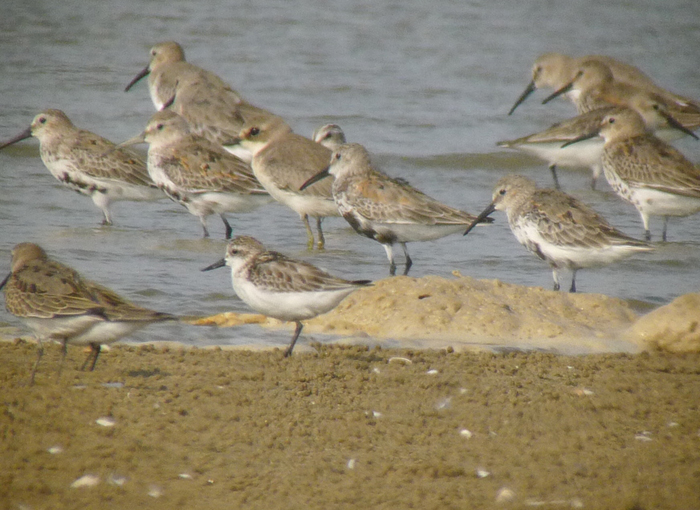
Thankfully, as the tide neared its crescendo, we received our wish: a “spoonie” landed with a small flock of Red-necked Stints, Dunlins, and Broad-billed Sandpipers near Gerrit’s blind. We got on the radio and tried to describe its location as it nervously ducked in and around the light caramel sea foam, picking invertebrates from the water’s surface.
We followed it for fifteen minutes, losing then finding it again as it weaved in and out of the assembled mixed flock of congeners. Few people have the opportunity to study this species in person, chances that decrease with the species population every year. Consequently, I was cherishing the full scope views this individual was providing.
My attention only waned when a Great Knot—another species of concern and my first for the trip—landed on the same stretch of beach. Undeterred by an eight-fold size discrepancy, the smaller Spoon-billed Sandpiper approached the back of the knot, stood up straight, and jumped up to throw his breast into the tail feathers of the knot. Twice.
“I just watched a Spoon-billed Sandpiper ‘chest bump’ a Great Knot!”
I guess the “spoonie” didn’t want to share the spotlight. Jason had my impromptu quote posted on Facebook within minutes.
We had three more days on Yubu Island and six more in South Korea, but this was my last interaction with Spoon-billed Sandpipers.

Of course, I would’ve appreciated a few more interactions with my favorite bird in the world, and a couple team members did while I was off collecting the sounds that would accompany Gerrit’s videos.
But Yubu Island still provided quite a bit: my lifer Black-faced Spoonbills, another rare waterbird that numbers in the low thousands; forays onto the mudflats at dawn where distant mountains were the only separation between the sky and its liquid reflection; armed with a parabolic mic and headphones, listening to the crispy percolation of millions of crabs feeding in the mud; finding myself amidst a feeding flock of Nordmann’s Greenshanks—another shorebird whose population numbers in the hundreds—frequently giving a gull-like call that’s never been recorded … only after I’d already left my recording equipment on the beach, a kilometer away; and an impromptu “round table” with the local fisherman of this island over a fresh caught lunch.
But, with a bird as special as this, I can always use one more look.
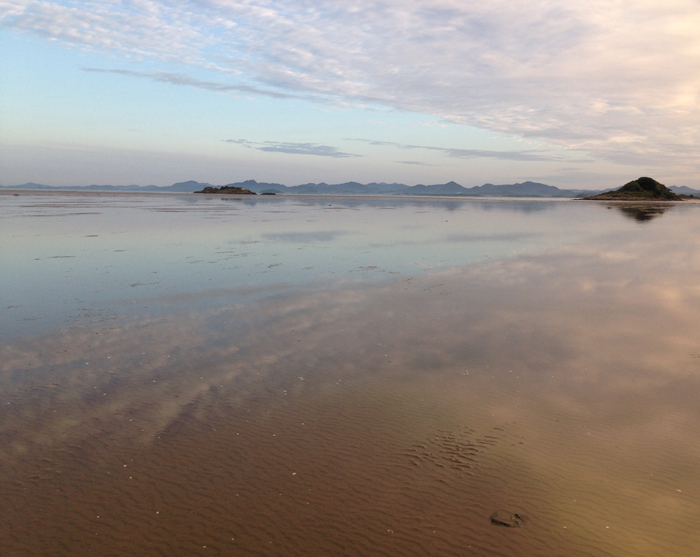 |
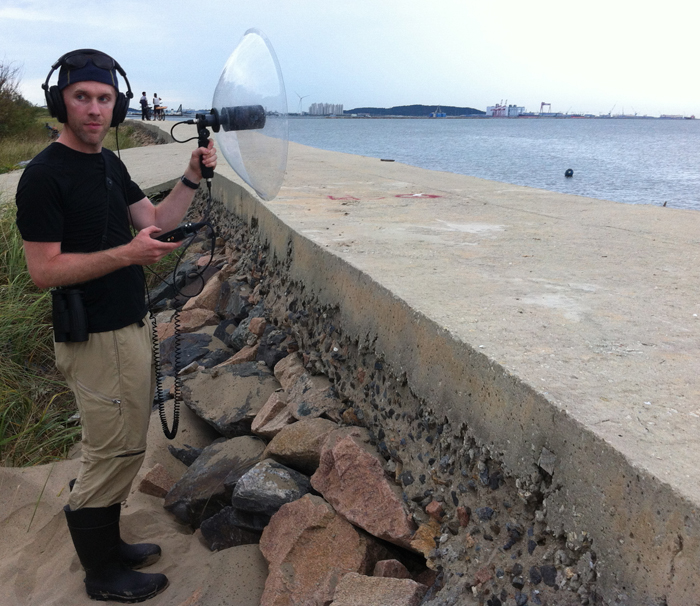 |
| Walking the Yubu mudflats at dawn | Me recording a backhoe on the back of a barge as it dropped rocks in to the ocean to build another breakwater © Jason Loghry (Birds Korea) |
